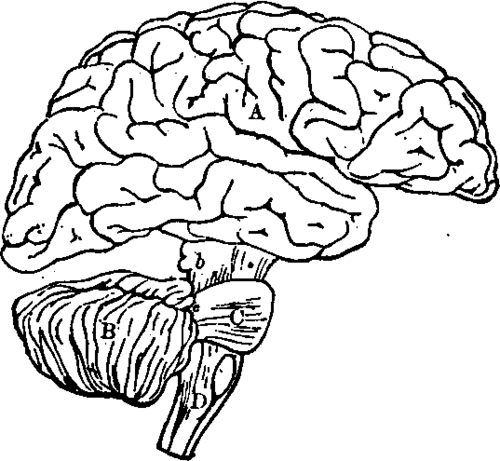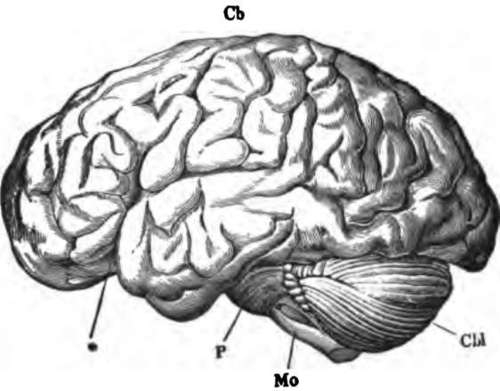The Brain
Description
This section is from the book "The Human Body: An Elementary Text-Book Of Anatomy, Physiology, And Hygiene", by H. Newell Martin. Also available from Amazon: The Human Body.
The Brain
The Brain (Fig. 82) is far larger than the spinal cord and more complex in structure. It weighs on the average about 50 ounces in the adult. The brain consists of three main masses, each with subsidiary parts, following one another in series from before back, and respectively known as the fore-brain, mid-brain, and hind-brain. In man the fore-brain, A, weighing about 44 ounces, is much larger than all the rest put together and laps over them.

Fig. 82 Diagram illustrating the general relationships of the parte of the brain. A, fore-brain; b, mid-brain; B, cerebellum; C, pons Varolii; D, medulla oblongata; B, C, and D together constitute the hind-brain.
What becomes of the common trunk formed by the mixture of the roots?
Point out characters in which the brain differs from the spinal cord. What is its weight? Of what main divisions is the brain composed? Which is the largest division? Its weight?
It is chiefly formed of two large convoluted masses, separated from one another by a deep fissure, and known as the cerebral hemispheres. The great size of these is very characteristic of the human brain. Beneath each cerebral hemisphere is an olfactory lobe (I, Fig. 84), inconspicuous in man but often larger than the cerebral hemispheres, as in most fishes. The mid brain, b, forms a connecting isthmus between the two other divisions. The hind-brain consists of three main parts: on its dorsal side is the cerebellum, B, Fig. 82; on the under side is the pons Varolii, C, Fig. 82; and behind is the medulla oblongata, D, Fig. 82, which joins the spinal cord.
In nature the main divisions of the brain are not separated so much as has been represented in the diagram for the sake of clearness, but lie close together as represented in Fig. 83; and the mid-brain is entirely covered in on its dorsal side. Nearly everywhere the surface of the brain is folded, the folds, known as the convolutions, being deeper and more numerous in the brain of man than in that of the animals nearest allied to him zoologically.

Fig. 83. The brain from the left side. Cb, the cerebral hemispheres forming the main bulk of the fore-brain; Cbl, the cerebellum; Mo, the medulla oblongata; P, the pons Varolii; *, the fissure of Sylvius.
By what is the fore-brain chiefly formed? What lies below the cerebral hemispheres? Are the olfactory lobes ever larger than the cerebral hemispheres? What does the mid-brain form? Name the main divisions of the hind-brain? State their relative positions. What part of the brain joins the spinal cord?
The brain, like the spinal cord, consists of gray and white nervous matter, but somewhat differently arranged; for while the brain, like the cord, contains gray nerve-matter in its interior, a great part of its surface is also covered with it. By the external convolutions of the cerebellum and of the cerebral hemispheres the surface over which this gray substance is spread is very much increased.
Continue to:
